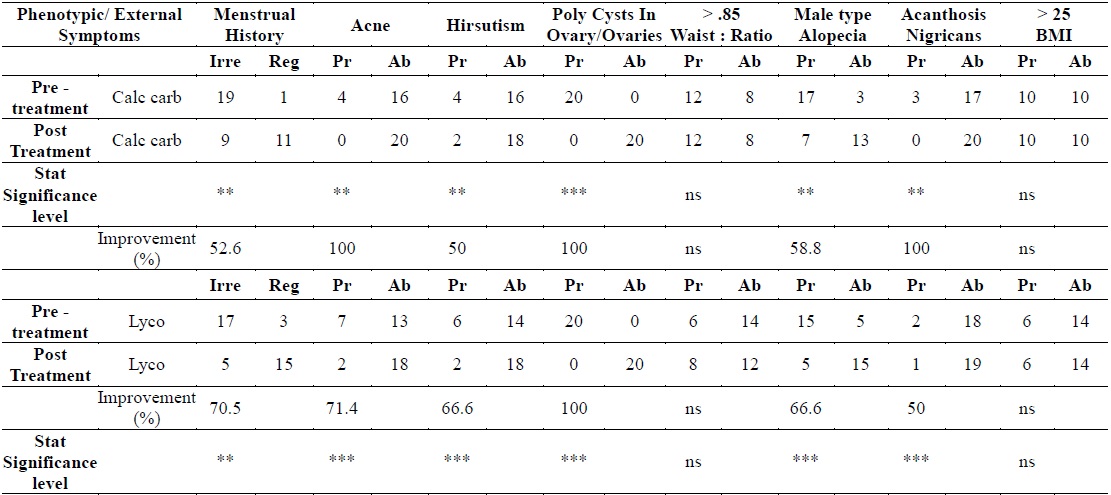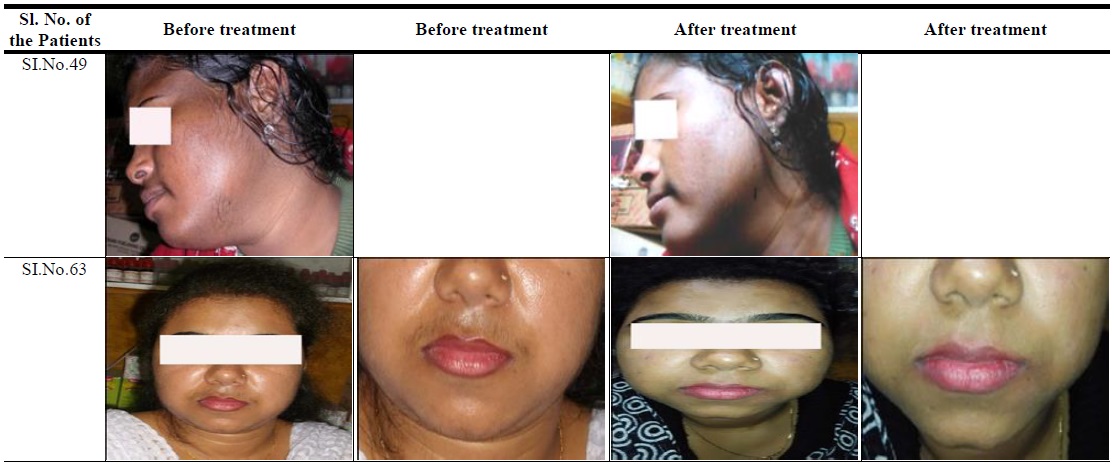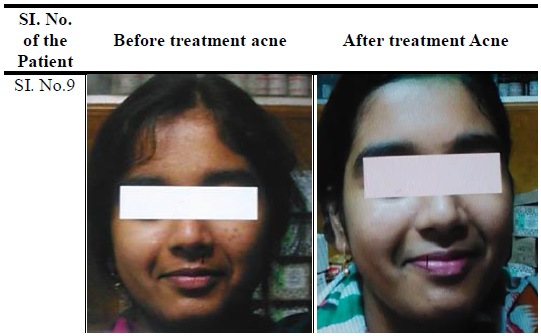



Polycystic ovarian syndrome (PCOS), a disorder otherwise described as cystic disease, is the most common endocrine disorder in all pre-menopausal women, affecting about 6.5 and 6.7% in females throughout the world (Asuncion et al., 2000; Diamanti-Kandarakis et al., 1999). However, according to the U.S. National Institutes of Health (NIH) criteria, the prevalence of PCOS has been calculated to be in the range between 6% and 10%, but this may go up to as high as 15% when the broader Rotterdam criteria are applied (Ganie et al., 2010). Systematic survey on the occurrence of PCOS has been poorly documented from India (Gill et al., 2012), and there has only been sporadic reports on successful treatment by some orthodox medicines (Farah et al., 1999; Knochenhauer et al., 1998), particularly with the use of laser technology by shattering the cysts (Farquhar et al., 2001, 2007, 2012; Karn et al., 2014); however, recurrence of cysts in many such cases has also been reported to occur (Bates and Propst, 2012). Further, in orthodox system, the diagnosis of polycystic ovarian syndromes (PCOS) often needs many tests like ultrasonography (USG), hormonal assays apart from some diagnostic phenotypic symptoms, resulting in the question of affordability of majority of patients for economic reasons and fear of side-effects. But many patients now-a-days deliberately go for treatment with some alternative medicines (CAM), and in India, homeopathy is a popular mode of CAM treatment that treats a subject holistically as based on some guiding symptoms and may use finally confirmatory tests to satisfy that the cysts have been removed or reduced in number and size, along with other guiding symptoms. However, one major factor that discourages many to adopt homeopathic treatment is the lack of methodical and systematic research to prove efficacy of any given drug. Therefore, in this study we pointed our attention on two potentized homeopathic remedies (potentized as per homeopathic principles and potencies selected were generally 30C/200C as per condition and improvement of individual patients and as per law of similia;
Therefore, in this study, we have made an investigation on such important symptoms which are generally associated with PCOS, but not always explicitly found in PCOS patients. However, our present aim was to test the modulating effects, if any, induced by these two homeopathic drugs used individually with different potencies of the drug, if and when necessary, on some 40 female patients from India diagnosed with PCOS by ultra-sonographic records (USG).
Thus, in this study the hypotheses to be tested were whether: i) potentized Calcarea carbonica (henceforth be called Calc) and
In this study, altogether forty women of reproductive age, who visited the clinics/outpatient department (OPD) of one of us (DD) at Chakdaha (rural), Asansol (semi-urban), Howrah and Kolkata (urban), located in the state of West Bengal served as subjects for this investigation. All patients signed “informed consent” forms that they agreed to get treatment by the registered homeopathic doctors (co-authors DD and SKK) and their data might be used in scientific publications for the benefit of others. To analyze the relative effectiveness of potentized Lyco and Calc, 20 patients each received the homeopathic drug (30th potency twice daily for 7 days, then the medicine was stopped for 7 days and again repeated in this manner, while the 200th potency, where necessary, was administered once a day for 4 days and then stopped for 7 days and repeated if and as required. The drugs were selected on the basis of holistic approach of guiding symptoms as recommended in Materia Medica and Organon (Allen, 1996; Boericke, 2002; Kent, 1985), i) to evaluate periodical changes of each diagnostic guiding symptom for each medicine; ii) and finally to get ultrasonographic confirmation if the cysts had been totally/partially removed/ or the cyst size/number reduced after the time course study fixed at 18 months from beginning of drug administration. Patients were periodically examined to note any alteration of external features including change in menstrual cycle, if any.
We kept five patients who were administered only placebo corresponding to the manner of “verum” treatment, but they did not show any measurable variation in respect of the phenotypic features (like hirsutism, acne, alopecia etc.) for which they were not considered for detailed analysis in this study. However, they showed subtle variation in data of the hormonal assay (included in the next paper in this series), which were critically examined and compared with the data of patients receiving “verum”.
>
Selection criteria for the 2 medicines
Patients who showed the guiding symptoms in totality (Allen, 1996; Boericke, 2002; Kent, 1985) for selecting either Lyco or Calc were first screened out into 20 patients in each group from about 180 patients visiting the clinics at different locations.
>
Selection of potency of drugs
In this study, mainly two potencies namely, 30th and 200th have been used depending on the condition of the patients and their symptoms (Close, 2001).
>
Method of preparation of potencies
This scale was introduced by Dr. C.F.S.Hahnemann in the 5th edition of Organon of Medicine, aphorism 270 and is more commonly used. Centesimal scale is based on the principle that the first potency must contain the one-hundredth part of the original drug and each succeeding potency, one-hundredth part of the preceding one (centesimal potency or C) with 10 succussions/jerks at each step of dilution. In brief, a perfectly clean and new phial was taken. To one part of the mother tincture, ninety-nine parts of a suitable vehicle like dispensing alcohol was added and mechanically jerked 10 times with uniform velocity; this makes potency one. Similarly one part of potency 1 is added with 99 parts of ethanol vehicle and given 10 jerks to produce potency 2 and so on (see Khuda-Bukhsh, 2003). In case of placebo preparation, only succussed alcohol without the original drug substance was used. The patients on placebo treatment subsequently were given actual drug treatment with the homeopathic remedies.
Medicines have been procured from Hahnemann Publishing Co. (Hapco), 165, BB Ganguly Street, Kolkata-700012.
The mean of values of all the data of at least three independent experiments were statistically analyzed using Student’s t-test and one-way ANOVA. P values of *
The changes noted before and after administration of the medicines in respect of all patients (N = 40) considered together and their levels of statistical significances, if any, have been summarized in Table 1. In Table 2, the comparative account of efficacy of Calc versus Lyco in respect of the individual external features/relevant traits of 20 patients in each group have been summarized, up to the end of 18 months of treatment at a regular interval (i.e. recorded at an interval of six months). Data of the Table 1 clearly showed that when the whole data of 40 patients were taken together, there were significant modulations in traits for both the drug treatment, most of them showing the difference as statistically significant. If the data are further analyzed, it would be revealed that in patients receiving potentized Lyco, irregular menstruation was fairly normalized in 12 patients out of 17 patients having initially menstrual irregularity, while 10 patients administered Calcarea carb showed normal menstrual cycle out of 19 initially reporting irregularity. Thus,

Showing data on external features recorded before and after administration of drug (total N = 40) in all patients considered together

Comparative efficacy of Calc and Lyco on 20 patients each in terms of statistical significance of differences between the two drugs in respect of different traits
Although various features have been implicated with the incidence of irregularities of menstruation and PCOS, like oligo-ovulation or anovulation, hyperandrogenism (either clinical or biochemical) (Witchel, 2015), and the presence of polycystic ovaries, the etiology of PCOS still remains obscure and there is urgent need to find out the frequency of occurrence as well as finding out possible early markers or salient physical features, if any, that would be of help in early diagnosis and treatment. In India, the study of PCOS in a systematic manner is rather scanty (Gill, 2012) and therefore needs immediate attention for more in-depth studies including critical survey for analysis of frequency and specific factors, if any, associated in development of this syndrome. Since PCOS is now found to be more common in women of reproductive age (De Frène, 2015) than was believed earlier, may be because of rapid change in life style and a fast life of the women in both developing and developed countries, the incidence of PCOS should no more be left unnoticed and neglected. PCOS has recently been implicated in impairing fertility as well as causing hormonal malfunctioning, which in turn may have influences on change in social behavior, and also affect some features which are more characteristically included as feminine ones
Homeopathy is a method of holistic treatment based on totality of symptoms. Most of the drugs used in homeopathy are mostly derived as ethanolic extract from part of plants, animals or minerals and are used in extremely diluted and potentized forms and that too in micro doses; therefore these ultra-highly diluted remedies have no or negligible side-effects or any adverse toxic effect. Homeopathic medicines are easy to obtain, easy to take and much cheaper, but what it lacks is evidence based research to validate their efficacy in certain disease conditions. Therefore, from the results of the present study, it would be clearly evident that both the drugs in this study which are more frequently used in the classical treatment of PCOS, indeed showed remarkable efficacy not only by accomplishing complete removal of cysts, but also played a great role in bringing about relevant physiological changes that appeared due to their influence on hormonal secretion. Obviously, some of the features/symptoms that we took into consideration in our study result from improper functioning of some hormones, more particularly the reproductive hormones. Therefore, more in-depth studies are warranted on certain reproductive hormones, specially the androgenic ones in female patients with suspected PCOS, which makes the next part of our research. Critical analysis of results of the assays of certain relevant hormones will make the basis of our next communication.
Because of advancement of civilization and scientific progress, there is much less physical exercise in day to day business or official work environment; change in food habit may be another single factor that possibly has contributed significantly towards development of PCOS. In a part of our earlier study (data unpublished) we noted that just by starting regular exercise under guidance of a trainer for six months caused considerable improvement in some features associated with PCOS, including the recovery of menstrual regulatory process in women. But quite a good percentage of women failed to recover only by exercise and that is where the role of these homeopathic remedies became obvious. Therefore, our present study should provide much greater confidence to both doctors and patients and can give benefit to a large number of women suffering from PCOS, only by taking these homeopathic remedies under the advice and supervision of qualified homeopathic practitioners; carrying out regular physical exercises can give additional benefits.
None of the authors has to declare any conflict of interest.






